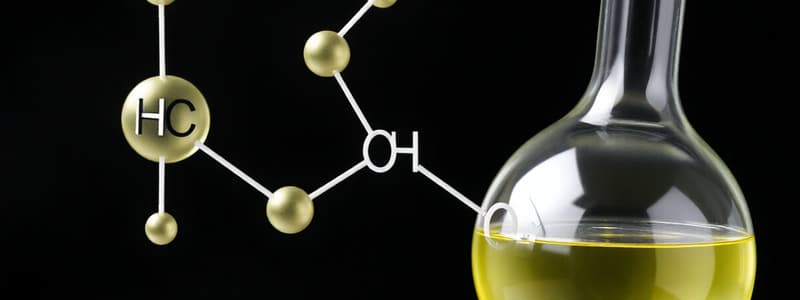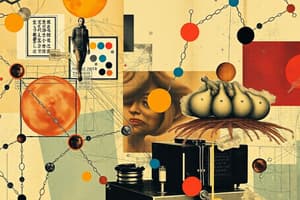Podcast
Questions and Answers
What type of bond is characterized by the sharing of electrons between two non-metal atoms?
What type of bond is characterized by the sharing of electrons between two non-metal atoms?
- Hydrogen bond
- Metallic bond
- Covalent bond (correct)
- Ionic bond
Which type of bond is typically formed between a metal and a non-metal atom?
Which type of bond is typically formed between a metal and a non-metal atom?
- Covalent bond
- Metallic bond
- Polar covalent bond
- Ionic bond (correct)
What is the primary factor determining whether a covalent bond is polar or non-polar?
What is the primary factor determining whether a covalent bond is polar or non-polar?
- The number of electrons shared
- The strength of the bond
- The electronegativity difference between the atoms (correct)
- The size of the atoms involved
In which type of bond are electrons described as existing in a 'sea' around positively charged atomic nuclei?
In which type of bond are electrons described as existing in a 'sea' around positively charged atomic nuclei?
Which of the following is an example of a homogenous mixture?
Which of the following is an example of a homogenous mixture?
When an ionic compound dissolves in water, what process occurs?
When an ionic compound dissolves in water, what process occurs?
Air is classified as which type of solution based on the states of matter?
Air is classified as which type of solution based on the states of matter?
Which of the following is an example of a heterogeneous mixture that will separate into layers over time?
Which of the following is an example of a heterogeneous mixture that will separate into layers over time?
Hand sanitizer, which is typically alcohol dissolved in water, is an example of which type of solution based on states of matter?
Hand sanitizer, which is typically alcohol dissolved in water, is an example of which type of solution based on states of matter?
Milk is identified as a colloid. What is the defining characteristic of a colloid compared to a suspension?
Milk is identified as a colloid. What is the defining characteristic of a colloid compared to a suspension?
Flashcards
Ionic Bond
Ionic Bond
A bond formed when a metal donates an electron to a non-metal.
Covalent Bond
Covalent Bond
A bond formed when non-metal atoms share electrons.
Non-polar Covalent Bond
Non-polar Covalent Bond
A bond between atoms with similar electronegativity where electrons are shared equally.
Polar Covalent Bond
Polar Covalent Bond
Signup and view all the flashcards
Metallic Bond
Metallic Bond
Signup and view all the flashcards
Hydrogen Bond
Hydrogen Bond
Signup and view all the flashcards
Solution
Solution
Signup and view all the flashcards
Homogeneous Mixture
Homogeneous Mixture
Signup and view all the flashcards
Heterogeneous Mixture
Heterogeneous Mixture
Signup and view all the flashcards
Suspension
Suspension
Signup and view all the flashcards
Study Notes
Types of Chemical Bonds
- Ionic Bonds: Form between a metal and a non-metal atom. The metal donates an electron to the non-metal, creating positive and negative ions. The charges balance, resulting in a neutral compound. Formation depends on the number of electrons in the outermost shell.
- Covalent Bonds: Formed between non-metal atoms. Atoms share electrons. Covalent bonds are generally stronger than ionic bonds.
- Non-polar Covalent Bonds: Occur when atoms have similar electronegativity, sharing electrons equally.
- Polar Covalent Bonds: Occur when atoms have different electronegativity, leading to unequal electron sharing.
Additional Types of Bonds
- Metallic Bonds: Occur between metal atoms, involving a "sea of electrons" shared among the atoms.
- Hydrogen Bonds: Form between hydrogen atoms and other atoms with a dipole (having a positive and negative end).
Solutions and Mixtures
- Solutions: Homogenous mixtures of one or more solutes dissolved in a solvent. Individual components cannot be visibly distinguished. Examples include sodas, seawater, air, and metal alloys.
- Ionic Compounds in Solution: When an ionic compound dissolves in a solvent, it breaks apart into its component cations and anions.
- Classifying Solutions by State of Matter: Solutions can be categorized based on the state of the solute and solvent. Examples include solid-solid (bronze), liquid-liquid (hand sanitizer), gas-gas (air), solid-liquid (sports drinks), liquid-gas (sodas), and gas-solid (hydrogen gas and platinum).
- Heterogeneous Mixtures: Mixtures that are not homogenous.
- Suspensions: Heterogeneous mixtures that separate into layers over time (e.g., sand in water).
- Colloids: Heterogeneous mixtures that do not separate into layers (e.g., milk).
Studying That Suits You
Use AI to generate personalized quizzes and flashcards to suit your learning preferences.




